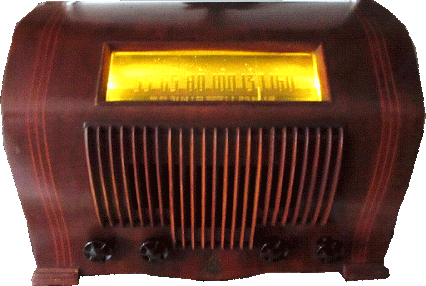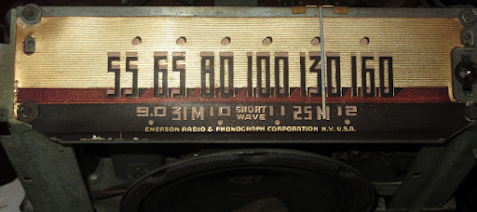Quite an expensive purchase for me but it was in good physical condition and complete, just needed a fault or two repaired and a scratch or two removed and it was a winner again.
Emerson being an American company that began life in 1915 as a phonograph company and still in use today. Emerson Radio & Phonograph converted to military production for World War II in 1942, the same year this radio was produced. It has two bands one MW (540-1620 KHz) or broadcast and the other short wave (8.8-12.2 MHz) and has a built in aerial for the MW band. It contains 5 x 6 volt heater and 2 x 25 volt heater valves all wired in series adding up to 80 volts + dummy load resistor R12, came to the US mains supply, 110 volts.
the repair
Nicely draw circuit diagram with valves lying on their sides and some strange looking symbols inside. I've discovered that American valve numbers start with the heater voltage, quite useful if your looking for a similar type. Just the mains diode valve was faulty, I bridged it with 2 BY127 type diodes plus I did however need to replace a few wax capacitors and the main smoothers (centre photo below) the valve would have popped off because of the smothers being OC, if ever you have humming on these old sets get the smoothers done before valve is destroyed.
The top of the photo above shows a strap that contains a shunt load resistor that's taped to supply 6.5v to the dial light bulb. I removed the bulb fitting and left the bulb inside when I fitted some LED's in it's place (Yellow type as the plastic dial window is tinted the same) I found a hole and spayed the volume control with cleaner and then touched-up the cabinet with filler and wood dye and bees waxed after that. I also attached a step down transformer to the aerial board (only free space) just above the fixing bolt.
 |
| built-in aerial where I fitted TX |
I had to re-sting the dial pointer too, a diagram is shown below for that, it can be a time consuming job and need the patients of a saint.
The cabinet was made by Ingraham & Co, founded in 1850 in Bristol, Connecticut USA, mainly doing cabinets for clocks, later came radios for Zenith and Emerson. It's similar to the bread bin design but has some nice curves like found on musical instruments, after all that's what a radio really is.The dial facia had turned black and cleaned up nicely wit a damp cloth, it has raised gold braid strips that catch the light well again now. Very pleased the the finished working and improved product. It's quite small for the year and very lightweight even with extra transformer fitted.







No comments:
Post a Comment